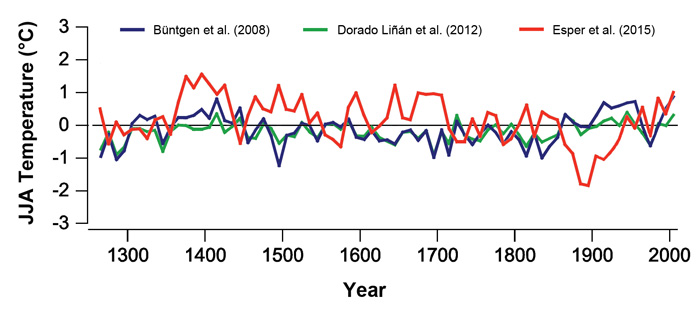| Tweet | Follow @co2science |
Paper Reviewed
Esper, J., Konter, O., Krusic, P.J., Saurer, M., Holzkämper, S. and Büntgen, U. 2015. Long-term summer temperature variations in the Pyrenees from detrended stable carbon isotopes. Geochronometria 42: 53-59.
Proxy temperature records serve a significant purpose in the global warming debate -- they provide a reality check against the claim that current temperatures are unprecedentedly warm in the context of the past one to two thousand years. For if it can be shown that past temperatures we just as warm as, or warmer than, they are presently, the hypothesis of CO2-induced global warming is weakened. It would thus be more probable that current temperatures are influenced to a much greater degree by natural climate oscillations than they are by rising atmospheric CO2.
Tree ring data account for one of the most commonly utilized sources of proxy temperatures. Yet, as with any substitute, proxy temperatures derived from tree ring data do not perfectly match with standard thermometer-based measurements; and, therefore, the calculations and methods are not without challenge or controversy. For example, many historic proxies are based upon a dwindling number of trees the further the proxy extends back in time. Additionally, some proxies mix data from different trees and pool their data prior to mass spectrometer measurement, which limits the ability to discern long-term climate signals among individual trees. Though it has the potential to significantly influence a proxy record, this latter phenomenon has received little attention in the literature -- until now.
In an intriguing new study, Esper et al. (2015) recognize this deficiency by noting "climate reconstructions derived from detrended tree-ring δ13C data, in which δ13C level differences and age-trends have been analyzed and, if detected, removed, are largely missing from the literature." Thus, they set out to remedy this situation by developing "a millennial-scale reconstruction based on decadally resolved, detrended, δ13C measurements, with the climate signal attributed to the comparison of annually resolved δ13C measurements with instrumental data." Then, they compared their new proxy with proxies derived from a more common, but presumably inferior, method based on maximum latewood density (MXD) data. The location of study was at a sampling site near lake Gerber (42.63°N, 1.1°E), Spanish Pyrenees, at the upper treeline (2400 m).
The resultant proxy temperature series is presented in the figure below along with two MXD-based reconstructions from the same region. As illustrated there, and as indicated by Esper et al., the new δ13C-based reconstruction "shows warmer and more variable growing season temperatures during the Little Ice Age than previously described [in the two MXD data sets] (Büntgen et al., 2008; Dorado Liñán et al., 2012)." In discussing why this is the case, they state that "developing this reconstruction required systematically removing lower δ13C values inherent to tree rings younger than 200 years, that would otherwise lower the mean chronology levels during earlier periods of the past millennium, where these younger rings dominate the reconstruction." In other words, the new methodology allowed the researchers to capture the low frequency climatic signals that were systematically eliminated in the MXD data sets. Thus, as a consequence, earlier warm periods during the late 14th and 15th, and 17th centuries "appear warmer" and "have been retained" by this new method, leading the team of six researchers to conclude that "late 20th century warming has not been unique within the context of the past 750 years."

Figure 1. δ13C based mean June, July and August (JJA) temperature reconstruction of Esper et al. (2015), compared with the MXD-derived JJA maximum temperature reconstruction of Büntgen et al. (2008) and May-September mean temperature MXD reconstruction of Dorado Liñán et al. (2012).
These results are significant for two reasons. First, it weakens the claim that the modern increase in CO2 is the primary driver of current temperatures. Second, if this new technique of deriving proxy temperatures holds as the more precise method, and if the relationships shown here are maintained, then it would be likely that most, if not all, MXD-derived reconstructions underrate the warmth of historic temperatures. For as noted by Esper et al. in the final sentence of their abstract, "the overall reduced variance in earlier studies points to an underestimation of pre-instrumental summer temperature variability derived from traditional tree-ring parameters." And that is a very big blow, indeed, to climate alarmists who continue to incorrectly claim that current temperatures are unprecedentedly warm. It likely just isn't so.
References
Büntgen, U., Frank, D.C., Grudd, H. and Esper, J. 2008. Long-term summer temperature variations in the Pyrenees. Climate Dynamics 31: 615-631.
Dorado Liñán, I., Büntgen, U., González-Rouco, F., Zorita, E., Montávez, J.P., GÓmez-Navarro, J.J., Brunet, M., Heinrich, I., Helle, G. and Gutièrrez, E. 2012. Estimating 750 years of temperature variations and uncertainties in the Pyrenees by tree-ring reconstructions and climate simulations. Climate of the Past 8: 919-933.
Posted 27 August 2015



